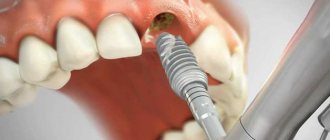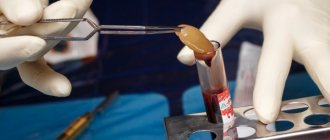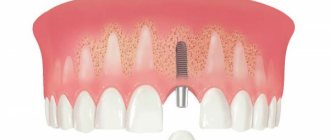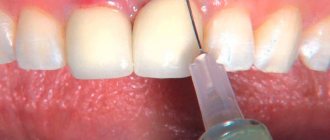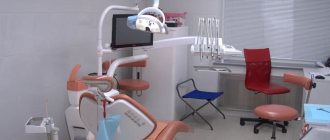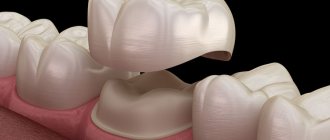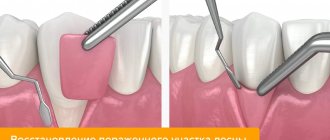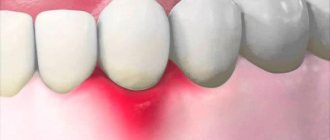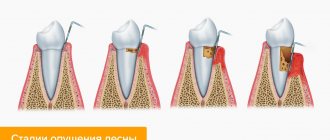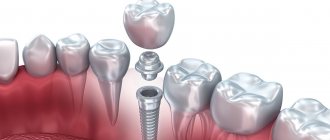- Questions and answers
- Stock
- Reviews
| Prices | Materials | Technologies | Alternative Treatment Options |
Lack of bone volume in the area of the dental defect is one of the most common relative contraindications to implantation. According to statistics, 70% of dental implants are installed in conditions of jawbone atrophy of varying severity. To solve this problem, many patients are prescribed one or another type of bone grafting.
Bone grafting (osteoplasty, sinus lift, bone augmentation) is an operation to increase bone tissue, which allows you to form a bed sufficient for installation of an implant. In some cases, bone grafting is performed simultaneously with implantation, and in some situations it is separated into a separate operation.
Why is there a need for bone grafting?
The roots of natural teeth are located in the spongy part of the jawbone called the alveolar process. This area of the jaw is riddled with blood vessels and nerves. The parameters of the alveolar processes are not constant values and change under the influence of various factors - the intensity of the chewing load, traumatic tooth extraction, endocrine or systemic diseases of the joints and bones. Let's consider how the lack of chewing pressure affects the jawbone due to tooth extraction.
The roots, thanks to the constant chewing load, keep the alveolar processes in good shape. When one or more teeth are lost, the jawbone in the area of the dentition defect ceases to experience pressure and gradually atrophies. Loss, or resorption, of bone begins several months after tooth extraction and can continue until the original volume is completely lost.
Depending on the location of the defect, bone tissue resorption occurs in different ways. Due to the fact that the density of the tubular bone in the upper jaw is several times lower than in the lower jaw, atrophy of the upper alveolar process occurs much faster. So, if in the lower jaw the process of bone shrinkage starts after 6-12 months, then in the upper jaw – already 2-3 months after tooth extraction.
Dentists distinguish the following types of bone atrophy:
- The alveolar process is reabsorbed across its width (horizontal atrophy).
- The alveolar process is absorbed in height (vertical atrophy).
- Resorption occurs in width and height simultaneously (combined atrophy).
Depending on the direction, degree and localization of resorption, various technologies are used to build up bone tissue for a dental implant. The chosen bone grafting technique, in turn, determines the type of osteoplastic material for bone augmentation.
What to expect after surgery?
In the first days after gum transplantation, the patient may experience pain and swelling. Painkillers and decongestants, which can be taken as prescribed by a doctor, help cope with these problems. A list of recommendations after the manipulation is compiled individually based on the physiological characteristics of each patient.
Prescribing general medications is necessary to stabilize the body and eliminate possible discomfort. The doctor may prescribe:
- Painkillers
- Decongestants
- Antihistamines
- Hemostatic drugs
The regimen for taking each drug is prescribed in the recommendation sheet.
The doctor’s most important recommendation is to keep the operating area quiet. This means that you cannot constantly pull back your lips or cheeks in order to see what condition the gums are in, since excess irritation can disrupt blood microcirculation in this area and negatively affect healing. It is also prohibited to sleep on the side of the operation and to perform aggressive tooth brushing. At the same time, a good level of hygiene is mandatory! But don't press the brush too hard or brush too close to the gum in the first few days.
Next, the patient should adhere to a number of dietary restrictions (too hot or cold, spicy or salty foods are not recommended). Heavy physical activity is prohibited for 7 days after surgery. Hygiene should be very gentle (aggressive cleaning with hard or electric brushes in the area of the operation is prohibited).
A separate ban concerns bad habits. Smoking can have an extremely negative impact on the graft engraftment process and cause some complications. If all recommendations are followed, rehabilitation is successful and without complications.
Materials for bone tissue augmentation during implantation
In implantology, osteoplastic materials are used in the form of granules, bone blocks and porous membranes. There are osteoplastics of mineral (synthetic) and biogenic (animal) origin.
To build up the jawbone during implantation, the following types of bone material are used:
- Autogenous - a piece of bone extracted from the donor area of the patient himself. The bone placed in the defect area is called an autograft.
- Allogeneic – the bone donor is another person. Allografts are taken in the event of a person's death, undergo special processing and are stored in donor tissue banks. Despite the ethical issues, allografts have a significant advantage, saving the patient from surgery to harvest his own bone tissue.
- Xenogeneic – material of animal origin based on bovine or pork bone. Used in the form of granules and bone blocks.
- Alloplastic - granules of synthetic origin based on calcium phosphate.
A separate group of osteoplastics consists of collagen membrane plates of animal origin. The main purpose of the membranes is to isolate the bone defect from the soft tissue of the gums and actively stimulate the repair of the jaw bone.
Types of bone grafting for dental implantation
To restore lost bone volume and install an implant, 4 technologies are used.
Splitting of the alveolar process
Description of technology: (see the process in the photo below)
the alveolar process in the area of the dental defect is sawed along the ridge with a dental cutter (1). The resulting hole is expanded with drills of different diameters (2,3), after which root-shaped implants are screwed in (4). The remaining cavities on both sides of the rods are filled with a synthetic or natural osteoplastic filler, covered with a resorbable membrane (5), and the gingival flap is sutured.
3-6 months after tissue regeneration is completed, abutments and temporary dental crowns are installed on the implants.
In the photo: Bone tissue augmentation before implantation by cutting the alveolar process
Indications:
This bone grafting technology is used to restore several teeth with horizontal resorption of the alveolar process at least 2 mm thick.
Important:
the method allows for bone grafting to be performed simultaneously with dental implantation, promotes rapid regeneration of bone tissue, and does not require surgery to collect autogenous bone material.
Bone block transplantation
Description of technology:
the operation is carried out in two stages.
- At the first stage, donor bone is collected from the chin area, from the cusps of missing wisdom teeth in the upper jaw, and in rare cases, from the ilium.
- At the second stage, autogenous bone material is placed in the desired area of the jaw using titanium screws. After this, the regenerated area is covered with a two-layer resorbable membrane and hidden under a gum flap.
Indications:
restoration of one or more teeth with severe bone resorption in width or height.
Important:
using your own bone significantly increases the chances of successful regeneration of the implanted block. This type of bone grafting does not allow you to immediately proceed to implantation. The implant is installed only 6-12 months after the first operation.
Guided bone regeneration
Description of the technology:
(see the process in the photo below)
the gums are opened (1), after which the area is injected with a natural osteo-replacement material based on bovine bone (4). The area is covered with a two-layer collagen membrane (5) to guide bone regeneration and sutured (6). Instead of a resorbable membrane, a non-resorbable film on a titanium mesh frame can be used.
In the photo: Guided bone regeneration simultaneously with the installation of 2 implants
Indications:
used for minor and moderate atrophy of bone tissue in width and height.
Important:
augmentation can be carried out simultaneously with implant installation and does not require surgery to transplant a bone block.
Sinus lift
Description of technology:
During the operation, the dental surgeon lifts the bottom of the maxillary sinus and fills the resulting cavity with a synthetic bone filler. Depending on how the manipulations to correct the bottom of the maxillary sinus are carried out, a distinction is made between closed and open sinus lift.
Indications:
the upper jaw in the area of 5-7 chewing teeth with the close proximity of the maxillary sinuses.
Important:
In most cases, implantation in the upper jaw is carried out simultaneously with a sinus lift.
Read more about sinus lifting in a separate article.
Prices for bone tissue augmentation during dental implantation in Moscow
The cost of the operation is determined by the following factors:
- Degree of bone tissue atrophy;
- Selected augmentation technology;
- Materials used.
A little about the cost of consumables:
Let's give an example of how the cost of augmenting bone tissue for an implant will change depending on the type of materials used.
| NPK "VITAFORM-R" (Russia) | Price | Geistlich Pharma (Switzerland) | Price |
| Xenocollagen granules Osteoplast-K | 1000 rub. | Xenocollagen granules Bio-Oss Spongiosa | RUB 14,650 |
| Resorbable collagen membrane Osteoplast* 30x40 mm. | 3800 rub. | Resorbable collagen membrane* 30x40 mm. Bio-Gide | 26,300 rub. |
| Total: | 4800 rub. | Total: | RUB 40,950 |
| NPK "VITAFORM-R" (Russia) | Price |
| Xenocollagen granules Osteoplast-K | 1000 rub. |
| Resorbable collagen membrane Osteoplast* 30x40 mm. | 3800 rub. |
| Total: | 4,800 rub. |
| Geistlich Pharma (Switzerland) | Price |
| Xenocollagen granules Bio-Oss Spongiosa | RUB 14,650 |
| Resorbable collagen membrane* 30x40 mm. Bio-Gide | 26,300 rub. |
| Total: | RUB 40,950 |
* The membrane is used only in some cases.
We do not skimp on consumables, and to guarantee our clients the success of the operation, we use only experience-tested, expensive materials.
Cost of bone tissue augmentation for implantation at the NovaDent clinic
| Osteoplasty technology | Price |
| Bone grafting in the area of one tooth | 9,600 rub. |
| Collection of autogenous bone material | from 10,150 rub. |
| Collection and installation of a turnkey bone block | from 39,400 rub. |
| Cutting of the alveolar process (price without installation of implants) | from 39,400 rub. |
| Sinus lift | from 25,300 rub. |
| Guided bone regeneration | from 25,000 rub. |
| Osteoplasty technology | Price |
| Bone grafting in the area of one tooth | 9,600 rub. |
| Collection of autogenous bone material | from 10,150 rub. |
| Collection and installation of a turnkey bone block | from 39,400 rub. |
| Cutting of the alveolar process (price without installation of implants) | from 39,400 rub. |
| Sinus lift | from 25,300 rub. |
| Guided bone regeneration | from 25,000 rub. |
How to do without bone grafting
The NovaDent dental center offers clients several alternatives to bone grafting. To avoid complications and if there are appropriate indications, we can perform dental implantation without bone tissue augmentation in the following ways:
- install compression-type implants into deeper layers of bone;
- install long root-shaped implants at an angle to the plane of the tooth or bypassing the maxillary sinuses;
- carry out a full jaw implantation on four or six implants.
Learn more about alternatives to osteoplasty.
The choice of treatment method is determined by the attending physician based on the results of the initial consultation and examination of the patient.
How to do without bone grafting
Is it possible to do without bone grafting and sinus lift?
Yes, in some cases you can do without bone grafting. But you need to understand that if the patient does not have bone tissue, and we install an implant, the crown will hang over the gum, and something from food will constantly get clogged there. That is, it is aesthetically unsightly, and all the food will be stuffed there, the patient will always have a “pocket of food supplies” from yesterday and the day before yesterday.
Option with a smaller diameter implant
You can place an implant of a smaller diameter, and at the same time we can carry out soft tissue regeneration - replant the mucous membrane (this can be connective tissue from the palate, from the tubercle of the upper jaw). And thus we achieve replenishment of the volume of soft tissues. Due to this, aesthetics are visually improved and hygiene problems are eliminated.
Whenever it is possible to avoid various surgical procedures, but not at the expense of quality, then they should be avoided.
That is, surgery for the sake of surgery - it is not needed
.
About bone grafting of the lower jaw
Implantation is the most advanced and aesthetic type of prosthetics and is successfully used to restore the integrity of the dentition in the absence of one or more teeth.
Often, as a result of various injuries to the jaw, complications after unsuccessful tooth extractions, previous diseases (granuloma, periodontitis) or atrophy as a result of prolonged absence of a tooth, a lack of bone tissue in the jaw occurs. In such cases, it is necessary to build up the dental bone.
Bone augmentation in dentistry helps restore the shape and aesthetically change the position of the jaw tissue, and provides the possibility of successful dental prosthetics by installing an implant.
Advantages and disadvantages
Advantages of compression dental implants:
- stable fixation
- use for moderate tissue atrophy
- atraumatic implantation
- rapid osseointegration
- suitable for single-stage protocol with immediate loading
Flaws:
- not used for single restorations
- if there is a large loss of tissue, the tissue is not suitable (only basal implantation or osteoplasty)
Implantation is not performed during pregnancy, breastfeeding and under 18 years of age.
Bone grafting at NovaDent clinics
For treatment and restoration of teeth, you are invited by the NovaDent network of dental clinics in Moscow and the region. Medical services here are provided by experienced specialists of the highest category. Modern equipment of clinics, the use of innovative technologies and advanced treatment methods allow them to carry out bone tissue augmentation during implantation with high quality and with minimal discomfort for the patient, minimizing the risk of negative consequences after surgery. Bone grafting in the lower jaw can be performed simultaneously with implantation. This is more comfortable for the patient. But if there is a clear lack of bone tissue, then a separate operation is performed.
Bone material for implantation can be obtained from donor bone from a patient (autogenous) or another person (allogeneic), synthetic (alloplastic) or animal origin (xenogeneic). The price of dental bone tissue directly depends on the type of material used.
The price for bone tissue augmentation in the lower jaw depends on the chosen technology, the material used, the degree of atrophy and is negotiated in each specific case only after a detailed examination by a doctor.
Our website contains the addresses of 15 NovaDent clinics in Moscow and the Moscow region, and a price list indicating the price of bone grafting of the lower jaw and other services for the treatment and restoration of teeth provided in our clinics. Promotions and special offers for payment for services are periodically held, and installment payments are provided. Clinics are open daily. Make an appointment by calling the phone number listed on the website. Contact the nearest NovaDent clinic at a time convenient for you!
Expert of the article you are reading: Griboyedov Pavel Olegovich Implantologist, Orthopedic Dentist, leading specialist of the NovaDent network
15 years
Clinical experience
Skhodnenskaya
Khimki Boulevard, 14, bldg. 2
+7
Free consultation with this specialist
Stages
1. Preparatory
The examination shows whether additional manipulations are needed, such as curettage or cleaning teeth from plaque.
2. Pain relief
The operation is performed under local anesthesia
3. Formation of flap, tissue extension
The epithelial tissue is capable of regeneration, and the patient's palate will not be damaged after the tissue is taken for transplantation.
4. Stitches and disinfection
The stitches are removed after 10-14 days.
Some clinics use a laser device instead of a scalpel. This reduces trauma and shortens the healing period, but increases the price of gum surgery after dental implantation.
